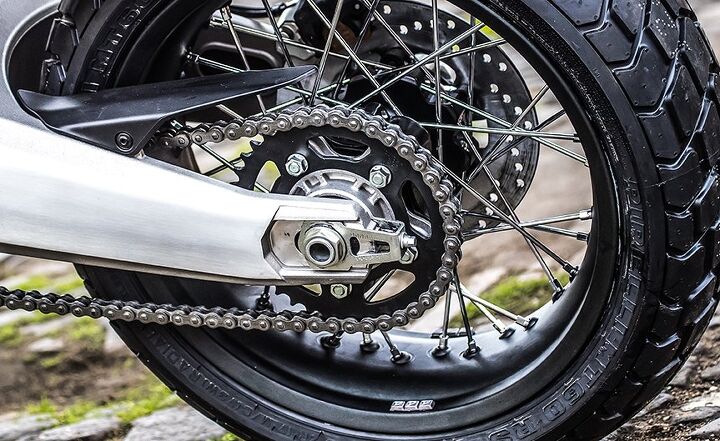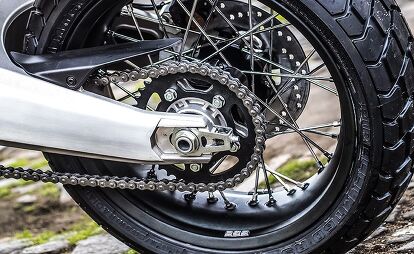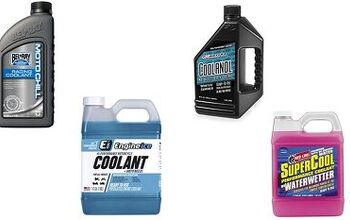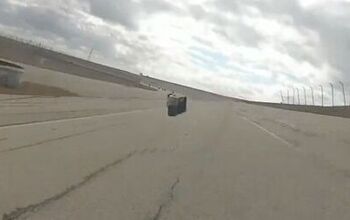Why Should You Change Your Motorcycle's Gearing?

Generally speaking, the first thing people look for when modifying their motorcycle is more power. It’s been so ingrained in our psyche to change the exhaust, let the bike breathe easier, and adjust the machine’s fueling (whether mechanically with a carburetor or digitally via electronic fuel injection) to gain a couple ponies. Next probably comes suspension, because power is nothing without control.
However, a topic not usually considered until much farther down the modification list is your motorcycle’s gearing. A discussion about gearing can get rather complex very quickly, so for the purposes of this story we’re going to stick to final drive gearing – that is, the relation between front and rear sprockets – and how different sprockets achieve different goals. Some of this information will apply to belt-driven motorcycles, but unfortunately for you shaft-drive folks now is probably a good time to click elsewhere on MO.
Before we begin, if you’re interested in the relatively simple task of changing your chain and sprockets, our 10 Steps To A New Chain And Sprockets story is a handy guide to follow.
Some background infoNow, the first step in understanding your chain and sprockets is to understand the relationship between the front (or countershaft) sprocket and the rear. When talking about final drive gearing, which we are in this case, we’re talking about the amount of revolutions needed by the front sprocket before the rear completes one full rotation. To find this number, divide the number of teeth on the rear by the number on the front. Keep this ratio in mind when choosing sprockets. Should the numerical value increase, you’re gearing the motorcycle “down.” That means a decrease in the ratio results in “gearing up.”
This is where the discussion about sprockets gets fun. Different people have different wants and needs for their motorcycle. A racer, or even a street rider, might want better acceleration. The racer’s excuse is to help them get a jump on the competition, while the street rider could use the extra boost simply to get out of the way of traffic easier. On the flip side, a touring rider might want their engine to spin at a lower cruising speed to help improve fuel mileage.
Okay, so what’s the answer?In short, the answer is gearing. For better acceleration, gear down (increase final drive ratio). To increase top speed, or in our example scenario, to reduce cruising rpm, gear up (decrease final drive ratio). In plain english, put a sprocket with more teeth than stock on the rear for better drive, or reduce the rear tooth count for lower engine speed for a given road speed. The amount doesn’t need to be huge, either; two extra teeth in the rear over stock can make a big difference.
Conversely, better acceleration can also be achieved with a front countershaft sprocket with fewer teeth than stock (one tooth difference is big). However, we prefer adding teeth to the rear as installing a smaller front sprocket makes the bend the chain has to make as it rotates around the countershaft sprocket tighter, causing unnecessary wear. As you can probably guess, adding a larger countershaft sprocket (compared to stock) will also do the trick of decreasing final drive ratio.
What can you expect?The thing with gearing is that you can’t have it all. Modern production vehicles, motorcycles included, are all about compromises. So if you want better acceleration, then add that bigger rear sprocket. Just keep in mind it’ll cost you top end speed, and your engine will be spinning faster at the same road speed. So, you might notice more vibration and will probably get worse fuel mileage. If you ride a small-displacement bike, this might be a good option, as top speed is far less important than being able to jump ahead of traffic.
On the other hand, decreasing final drive ratio by adding a smaller rear sprocket will net you a higher top speed and reduce engine speed as you’re cruising down the highway, but your motorcycle won’t accelerate to that speed with the same gusto as it did before. If your motorcycle makes a lot of torque, then the consequence of a smaller rear sprocket may hardly be noticeable. It’s a tradeoff; one only you can decide is right for your situation.
ConcernsFor the most part, adjusting your gearing in either direction can make a significant change to the motorcycle, however the one thing to keep in mind is that gearing changes could also affect your speedometer and odometer, depending on how your motorcycle reads speed and mileage. In rare cases, a sprocket change could actually put your speedo and odo back on track, if the stock stuff doesn’t read true for some reason. Either way, the aftermarket is full of solutions to get your clocks to read correctly, if needed.
Lastly, when changing your sprockets, it’s always a good idea to replace the chain at the same time. As these are wear items, you want the chain and sprockets to wear evenly and together. Replacing one without the other is cause for premature wear at best, catastrophe at worst. Also, keep in mind that gearing changes could necessitate a different chain length than you had before. One final thing to keep in mind, since you’re now searching for chains anyway, is the pitch of your chain/sprocket combo. Going to a smaller pitch, meaning narrower chain/sprocket, is lighter and thus reduces your unsprung weight. For performance-oriented riders, this is a tangible difference you can feel. Generally speaking, the tradeoff here is a shorter lifespan of the chain/sprocket combo, but some companies make hardened steel sprockets with considerable lifespans that debunk this rule.
What’s right for you?Ultimately, it’s up to you to decide what, if any, gearing changes you want or need for your motorcycle. While this guide is by no means complete, it should at least get you started thinking about pros, cons, and concerns. And should you be in the market for a new set of chain and sprockets, some of the companies we like to use are Vortex, D.I.D., Regina, Renthal, RK Racing, Supersprox, and Pro Taper, just to name a few.

Troy's been riding motorcycles and writing about them since 2006, getting his start at Rider Magazine. From there, he moved to Sport Rider Magazine before finally landing at Motorcycle.com in 2011. A lifelong gearhead who didn't fully immerse himself in motorcycles until his teenage years, Troy's interests have always been in technology, performance, and going fast. Naturally, racing was the perfect avenue to combine all three. Troy has been racing nearly as long as he's been riding and has competed at the AMA national level. He's also won multiple club races throughout the country, culminating in a Utah Sport Bike Association championship in 2011. He has been invited as a guest instructor for the Yamaha Champions Riding School, and when he's not out riding, he's either wrenching on bikes or watching MotoGP.
More by Troy Siahaan







































Comments
Join the conversation
With an understanding that the manufacturers employ engineers with more knowledge than most people have, it’s a good practice to accept that most bikes are delivered from the factory with a completely acceptable compromise package of sprockets. I always adapt to the bike rather than the other way around. Ride safe. Ride often. ...but most importantly, ride smart!
I always found the stock gearing on my vfr800 to be aimed a bit to much at the touring part of sport touring so with my last chain I reduced gearing about 12% and now it feels much more lively without the revs being too high on the freeway. Mileage is close enough for my range between fill up to stay the same.